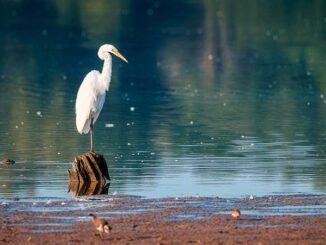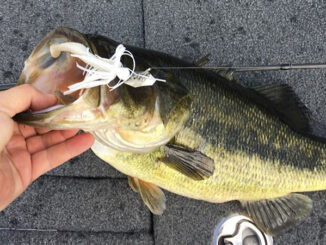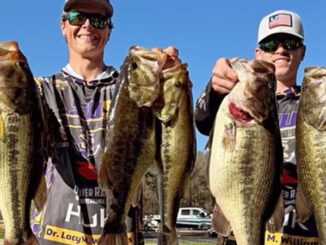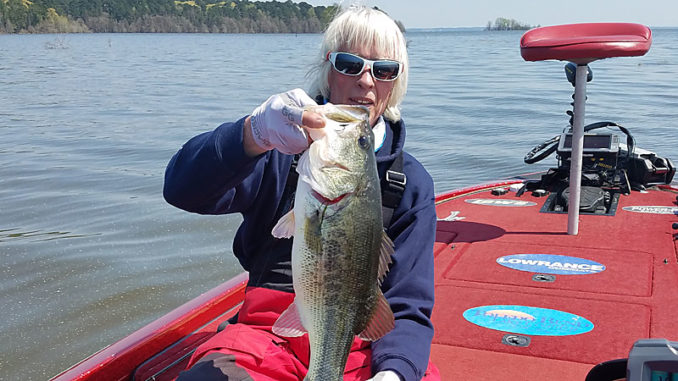
Low water shouldn’t slow down the action in what looks like is going to be a great time
Entering what many regard as the most-promising month on Toledo Bend to catch bass — both quantity and quality — average water temperatures will have more to say about the degree of success than the water level, which could be 7 feet lower than it was in February 2019.
It’s going to be an absolute fun time to fish for bass on this great lake, whether we get more water or not. It’s a great opportunity to get a trophy bass and, sooner or later, that lake record of 15.33 pounds is going to fall. It may be this month someone pokes one over 15½.
The prespawn
The approaching prespawn is a time when you can catch bass on so many lures — bladed jigs, jerkbaits, lipless crankbaits, spinnerbaits, etc., mostly in 5- to 6-foot depths. I won’t venture deep to get bit because, generally, I don’t have to.
Bass were really biting the first week of January. It’s just a matter of time before we start getting double-digit bass weighed in. The lake’s level the first week of January was 165.25; last year at the same time, it was 173.15, a foot and 3 inches above full pool.
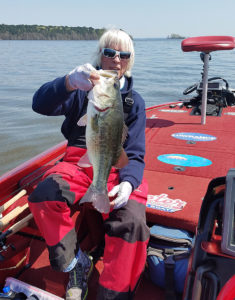
Do we want the lake to come up, which it inexplicably does, or stay down? It’s kind of a Catch-22. If it stays low, it would be great to see the hay grass and maybe other green stuff grow in the exposed acreage, and there’s a lot of it. If it goes up, we’ll have fish in the bushes.
I’m thinking it will remain low, but I’m aware a prolonged deluge or two or three will fill this pond. The water level will determine where bass set up, and the water temperature is a good gauge on when they move. Water temperatures will range from the 50s to the 60s. That’s how it goes with weather systems.
What to use at the end of February
More bass will be moving up the later in the month. As long as the food source stays shallow, they’ll be around, but they might get sluggish, which is when it’s time to break out the Zoom Super Fluke and/or a Neko Rig.
Otherwise, one artificial lure that must be tied on is a Rat-L-Trap, either ½- or ¾-ounce. The heavier model gets you bigger bass, so that’s a must for tournaments over the next six weeks. The lighter Trap triggers more bites most of the time. Reddish Rat-L-Traps — and there are many color combinations of red — usually are most effective. Maybe even try a shad-colored Trap.
Also try a bladed jig, such as a black/blue or green pumpkin Delta Lures Thunder Jig. I’ll have two rods loaded with gold/orange Rogues, a pro model and a suspending model. Also, offer a 6-inch square-bill crankbait, preferably in Rayburn Red color. If it gets slow, feed them a watermelon/red or green pumpkin/red Fluke or Neko Rig with a similarly colored soft plastic.
Fish the back drains, the back coves, the ditches. Water color could go from green to off-color. After heavy rains, it’ll tint up for sure; that’s why red-hued artificials are the ticket.
A sure-fire tactic
If the water remains low, try this tactic that worked for me in the 1980s during low-water period with very little, if any, hydrilla in the San Miguel and San Patricio areas. Target wood — stumps, deadfalls, trees, etc. — in 5-foot depths anywhere in the lake, although there is a lot more wood on the upper end.
For those glorious weeks that February and early March, I caught so many bass, including many hawgs. With this low water and grass situation, it might be the same deal this month.
Take a plastic lizard and cast or pitch past a stump so the lizard bumps the base of the stump on the retrieve. The line must rub the stump, and the bait can’t be in front of it. The bigger the stump, the more likely a bass will be on it.
White perch fishing should be getting very good in February. How many times do you have a Rat-L-Trap stopped dead in its tracks and reel in a 1¾- to 2-pound slab? That’s when it’s time to stop and fish the area with pink/white Road Runners, so have one or two light rods rigged up.
